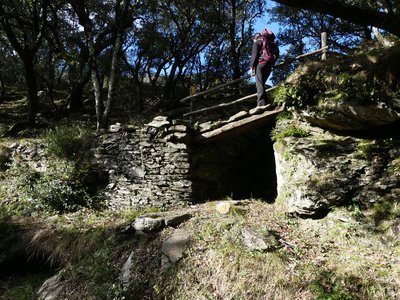
Champdomergue
9 points of interest

Loutre d'Europe - © Regis Descamps  Fauna
FaunaBrook fauna
The otter was once much coveted and hunted for its pelt. Over 30 years passed before it settled in the waterways of the Cévennes again. Since then, its presence in the National Park has been well-known through monitoring of its tracks and other indicators. The population of white-clawed crayfish, on the other hand, is shrinking; it is very sensitive to environmental variations. To preserve it, habitat diversity and especially water quality are key.
Béal - nathalie.thomas AgricultureThe béal (irrigation channel)
On large slabs of stone, the path straddles the béal which irrigates the crop terraces, and whose starting-point is 1.5km upstream.
“I know that several people had a right to the béal, and they each had their day to use the water. Where I lived there were at least 3 kilometres of béal, and to maintain them, we’d work in March and autumn. Nowadays you can water the parcels with a hose but it doesn’t distribute the water like a béal. When there were channels everywhere, everything was green, now it’s all dry”.
Un hôtel accueillant - Olivier Prohin  Natural environment
Natural environmentA welcoming place to stay
This chestnut tree and the ruined clède (chestnut-drying building) are the relics of a chestnut grove that was abandoned long ago.
The tree is dead… but full of life. National Park rangers take part in the national inventory of saproxylic beetles (which eat dead wood). Trapping, observing and identifying the species are the key stages of this work. The known reproductive and over-wintering sites of bats, which are victims to habitat loss and light pollution in particular, are also counted.
Bancels - nathalie.thomas AgricultureBancels (crop terraces)
“They used to have their gardens over there, in Cessenade, they planted tomatoes, beans… because the village wasn’t hooked up to the water mains yet. The bancels were walled in to keep back the soil, with an opening just large enough for one man and his load of manure, they carried everything on their backs, even a mule couldn’t get there… Back then, there was so much to do that on evenings when the moon was full, they would repair the low walls, and there were people, this is really long ago, who took on a labourer to help them and they paid him with two or three basketfuls of soil that he would take back to his own bancels.”
Olivier Prohin AgricultureCultivated chestnut trees
These can be spotted by their bulge, which is the scar left by grafting. Here, you can see the chestnut tree in various forms: as a stand that is wasting away, in a maintained orchard (in front of you) or mixed with pine or holm oak (behind you).
The comballe variety predominates in this area but many other varieties are grown in the Cévennes, thus guaranteeing a long harvest period and better resistance to diseases, insects and climate whims.
Vue sur le viaduc de Cessenades - Olivier Prohin  History
HistoryThe departmental railway (CFD)
Inaugurated in 1909, the departmental railway (CFD) linking Florac with Sainte-Cécile d’Andorge required 15 tunnels and 53 road and rail bridges. It was closed down in 1968 for lack of profitability. The line is being progressively turned into a walking and cycling path, which offers picturesque views over the meanders of the rivers Mimente and Gardon d’Alès (Vallée Longue).
Champdomergue - nathalie.thomas  History
HistoryChampdomergue
In the field are the ruins of Champdomergue where, in 1702, the first confrontation of the Camisard War took place between those fighting for freedom of conscience and Louis XIV’s soldiers. Champdomergue was a commemorative site until 1937.
In 1943 and 1944, Champdomergue sheltered a Resistance unit of German and Spanish antifascists, Armenians and Russians (deserters and escaped prisoners) and French men. They actively participated in the Vallée Longue Resistance through various acts against the Gestapo and the French Milice.
La voie ferrée - nathalie.thomas  History
HistoryThe railroad
The railway was primarily used to transport goods and passengers. In 1943-44, more than 120,000 people travelled on this line every year. Chestnut and maritime-pine wood were taken down to the plains and coal, materials and goods for shopkeepers were brought up. “People took the train to sell their products and produce at the market in La Grand-Combe. That market financially supported the whole area. There were big crowds there, and miners earned a good living in those days, so they didn’t pinch pennies at the market.”
Evolution de la forêt - Olivier Prohin  Natural environment
Natural environmentThe hidden side of the ravine
Alongside the former railroad, the forest is spontaneously evolving towards more diversity and maturity. After broom and heather come pine and birch. These stands enrich the soil with organic matter and prepare the arrival of true forest: holm oak, chestnut and then downy oak, all species that grow slowly and are ecologically demanding.
Description
1) Turn right onto the disused railway.
2) Immediately after the railway bridge, take the little path on the left that goes uphill via Rome to join up with a track on the ridge.
3) Turn right onto this track until you reach the road, which you take downhill through Leyris Bas. Past this hamlet and a spring, take the path that goes uphill on the left. You climb through a reforested area of pine, Douglas fir and spruce, crossing a forestry track several times.
4) When you reach the ridge track, take a track on the left to Champdomergue. Walk around the meadow on the left. At the road, turn right and go downhill to the pass.
5) Below the pass, take the track on the right.
6) At the first intersection, go downhill on the left and continue on the main track. Then take the road downhill to Altavias, La Borie and Soulatges.
7) Take the path downhill to Burjas, which runs above the disused railway.
8) Take the disused railway for 750 m.
9) Fork left onto a path that comes out on the N 106. Turn right onto the road to get back to your car.
- Departure : N106: hairpin bend below La Blacherette (at Champernal bridge)
- Arrival : N106: hairpin bend below La Blacherette (at Champernal bridge)
- Towns crossed : Saint-Privat-de-Vallongue and Ventalon en Cévennes
Forecast
Altimetric profile
Recommandations
Information desks
Tourism'house and national Parc at Florac
Place de l'ancienne gare, N106, 48400 Florac-trois-rivières
This office is part of the National Park's associated tourist-information network, whose mission is to provide information on, and raise awareness of, the sites and events as well as the rules that must be observed in the National Park's central zone.
On site: exhibitions, video projections, events and shop Open year-round
Office de tourisme Des Cévennes au mont Lozère
le Quai, 48220 Le Pont de Montvert sud mont-Lozère
Tourism office Des Cévennes au mont-Lozère, Saint-Germain-de-Calberte
Village, 48370 Saint-Germain-de-Calberte
This office is part of the National Park's associated tourist-information network, whose mission is to provide information on, and raise awareness of, the sites and events as well as the rules that must be observed in the National Park's central zone.
Open year-round, except for 2 weeks at Christmas
Access and parking
Parking :
Calculateur d'itinéraire Lio
Utilisez le calculateur liO pour organiser votre trajet en région Occitanie.
Autres régions
Calculez votre itinéraire en Auvergne Rhône Alpes sur Oùra
Biodiversité autour de l'itinéraire
Source


Report a problem or an error
If you have found an error on this page or if you have noticed any problems during your hike, please report them to us here:



